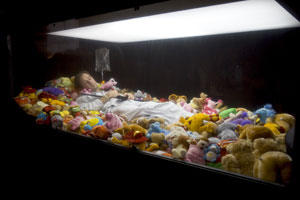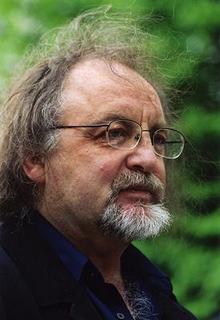News from Bayreuth
Following up on my first Bayreuth post this year (Oh, Bwoonhilda, You're So Wovewy, July 25), there is no real controversy to speak of, but they are still performing Wagner's operas in the Festspielhaus. In general, however, the critical reception has been lackluster, to say the least. Are the best of the best (singers and others, with Plácido Domingo excepted) just not lining up to go to Bayreuth anymore? Here's a sampling of press reviews I have read of the five operas staged this year:
Tristan und Isolde:
- Andrew Clark, Obsessive love in a 1940s setting (London Financial Times, July 27)
An ordinary man and woman fall for each other. Theirs is an all-consuming love - compulsive, illicit and ultimately futile. It not only undermines their will to live, it poisons all the relationships in their orbit. This is the scenario proposed by Christoph Marthaler in his new production of Tristan und Isolde at the Bayreuth festival. Wagner's great hymn to romantic love is not about sex or passion. Nor has it anything to do with metaphysics or the cosmos. No, it is about the destructive loneliness of love, an obsession that can lead only to extinction. On these terms Tristan und Isolde is a modern story. But do we need to go to Bayreuth to experience it? Marthaler, a Swiss director who staged a controversial Figaro in Salzburg three years ago, has done his usual thing of showing opera characters as everyday types, but there was nothing revelatory about Monday's performance. The conductor, Eiji Oue, kept musical passions running high. Marthaler was booed; the cast was cheered.
- Christian Merlin, Wagner en roman-photo (Le Figaro, July 27)
So we just have to say it: we did not see the season's best Tristan in Bayreuth. The director is far too talented for us to speak of a failure, but between a promising beginning and a moving ending, it was mostly a frustrating evening. Is Marthaler afraid of myth and metaphysics? His lovers are the heroes of a picture novel or a musical comedy, whose process of maturing has tragic consequences.
- Manuel Brug, Auftakt in Bayreuth: Christoph Marthaler beleuchtet Wagners größte Liebesgeschichte (Berliner Morgenpost, July 27)
- Hans-Klaus Jungheinrich, Hero to Zero: The unspectacular failure of "Tristan and Isolde" at Bayreuth (Sign and Sight, July 27)
It was sobering but not annoying: an unspectacular disappointment. The idea was interesting: putting the opera of the most extreme rebellions and exaltations together with the directorial master of abysmally shrewd and pensive staidness. What resulted was the insight that a good piece plus a good director does not necessary equal an extraordinary performance if those 'goods' are of a controversial nature, as was the case here.
- Anne Fournier, Christoph Marthaler hué à Bayreuth (Le Temps, July 30)
- This year at Bayreuth there was no redemption for Lohengrin (Associated Press, July 26)
But the gloom grows even thicker in Keith Warner's revived production. Instead of fading away gloriously into the sea horizon as he returns to join other knights of the holy grail, Lohengrin is ingloriously swallowed up by the ground. The swan - a symbol of redemption - is carried in dead at the end of the final act. And in the place of a grown warrior - Elsa's brother reincarnated from swan to human - the hero leaves behind a weak boy unable to lift his sword, let alone defend the Brabant duchy, like he was supposed to as Lohengrin's surrogate.
- Andrew Clark, Lohengrin Festspielhaus, Bayreuth (London Financial Times, July 28)
When a production is revived at Bayreuth, it usually works better than when new. That is because revivals here, unlike metropolitan theatres, get thorough rehearsal, with the original team in attendance and quirks in casting ironed out. It is what Wolfgang Wagner, the composer's 85-year old grandson and festival director, used to call "Werkstatt Bayreuth" (Bayreuth workshop), though the term is not heard much now. Lohengrin, directed by Keith Warner and designed by Stefanos Lazaridis and Sue Blane, shows that the workshop approach does not always work.
- Christian Merlin, Nuit gothique (Le Figaro, July 28)
Those who hated the new Tristan und Isolde staged by Christoph Marthaler for the opening of the Bayreuth Festival celebrated the reprise of the Lohengrin conceived by Keith Warner. But was it for the right reasons? They booed Marthaler's modernized minimalism, but they applauded the armor and medieval ambiance, thinking that they had finally found the "real" Wagner. But was there not ultimately more theater in Marthaler's horrible huis clos (no exit) than in Warner's cloak and dagger spectacle?
- George Jahn, 'Hollaender' Takes Liberties With Wagner (Associated Press, July 28)
- Christian Merlin, Une distribution vocalement indigne (Le Figaro, July 29)
Succeeding Eiji Oue, overwhelmed by the events in Tristan, and Peter Schneider, comfortable but routine in Lohengrin, the third night of the 2005 festival was conducted with verve by Marc Albrecht: nervous gestures and bright peaks, compact dramatism, at the edge of stiffness but nevertheless moving. Shouldering aside soloists and choir a bit in the fast parts, he did not tolerate any dead time. Too bad! The casting was not worthy of a festival that should be the Wagnerian ideal. [...] Whoever may have started listening to a radio broadcast of this performance would not have believed that it was from Bayreuth, where the casting should be an example, either with renowned artists or with up-and-coming young singers, but certainly not with players that a first division soccer team would have recruited as substitutes and not as first-stringers.
The music came from Wagner at Wednesday's Bayreuth Festival production of "Der fliegende Hollaender" but the plot came from Freud. Wagner's Senta, abused by her father, dreams up a fantasy lover -- the flying Dutchman -- who will whisk her away from her stifling bourgeois surroundings; she redeems the Dutchman from an eternal fate at sea by casting herself into the waves at the end of a stormy 2 1/2 hours -- much of it on deck or on the yardarm. But not a glass of water was seen in Claus Guth's production, and the action was in the mind instead of the ocean.
- George Jahn, A little kitsch, lot of fine music in Bayreuth Festival's Tannhaeuser (Associated Press, July 28)
Under Christian Thielemann, arguably the best Wagner conductor of the day, the Festival Orchestra masterfully underpinned the haunting pilgrims' choruses, set the ground for the chromatic harmony that depicts the tonal world of Venus, or worked its magic in the orchestral preludes that create the mood for the acts to follow. In an unusual act of homage reflecting the orchestra's performance, Thielemann brought the musicians on stage for a curtain call - many of them in shorts and sandals to beat the heat - in a gesture normally reserved for the end of the festival.
- Julian Sykes, La petite musique de Bayreuth (Le Temps, July 30)
- Festival de Bayreuth: ovations pour Pierre Boulez (ATS, July 30)
The French conductor Pierre Boulez was given a standing ovation by the audience Friday night in Germany, at the conclusion of the performance of Parsifal at the 94th Bayreuth Festival. [...] As happened last year during this production, the iconoclastic staging by the bad boy of German theater, Christoph Schlingensief, which uses video with images of dead rats, was soundly booed by a part of the audience.
- Christian Merlin, Bayreuth : «Parsifal», le syndrome Avignon (Le Figaro, August 1)
In spite of his spats last summer with Wolfgang Wagner, the festival's director, Schlingensief has come back to develop his staging in a more serene climate. But if some aspects have been modified (the artist is said to change ideas every twenty minutes), the spirit remains. It poses basic aesthetic, even philosophical, problems. It is impossible to describe here all of the production's details. Just know that Avignon Syndrome has struck again: Schlingensief, an artist, has created an installation and not a staging. His method of expression: the revolving set and the projection screen. [...] We should have sent our contemporary art critic to Bayreuth instead of a music critic like me. Because what we saw was a work by Christoph Schlingensief after Parsifal, accompanied by the music of Richard Wagner.
- No Sweat, Angela (Deutsche Welle, July 28), on the leading candidate for the German chancellorship, Angela Merkel, sweating on the red carpet at Bayreuth opening night (as Barry at bloggy put it, she is one of the Politicians that consider opera part of life)
- Patti Smith schreibt über Bayreuther Festspiele (Frankfurter Rundschau Online, July 31), on American rock singer Patti Smith, who, it turns out, loves opera, always dreamed of singing opera, and was interviewed by Die Zeit in Bayreuth this year (!)
































































